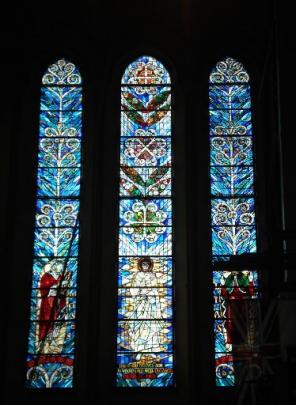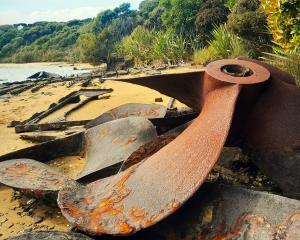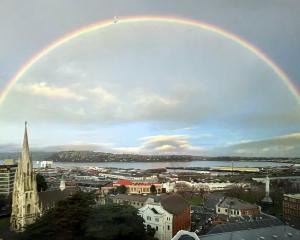Scores of intricate and colourful stained-glass windows have been casualties of the Christchurch earthquakes, including many created by Dunedin master glass craftsman, the late Roy Miller. Three of his most elaborate windows are still intact, but at risk, in one wall of the badly damaged Christchurch Cathedral. Mr Miller's nephew, Brian Miller, of Dunedin, is writing a book about his uncle's work and warns there are stained-glass windows at risk throughout New Zealand.
Master glass craftsman Roy Miller always wanted to make stained-glass windows for the three tallest windows in New Zealand, located in Christchurch Cathedral.
As Miller was heading for retirement, Miller Studios of Dunedin gained the contract to make these windows - "the Scott Memorial Windows" - and Miller worked with Paul Hutchins for months to produce them.
However, Miller never got to see the windows in position.
In 1981, just after painting the face of Christ at the centre of the windows, he died of a heart attack and now the existence of those three windows themselves hangs in the balance as they sit inside the ruined cathedral.
The technique of making stained-glass windows began during the massive church and cathedral-building period of the Middle Ages, but lost favour as architectural styles changed.
A revival of stained-glass window-making in Europe in the 19th century coincided with the building of churches in the new colony of New Zealand.
Initially, windows were imported, mostly from Great Britain. However, Miller was instrumental in breaking that mould and beginning the development of New Zealand-made windows.
Dunedin was the height of culture in New Zealand following the late 19th-century gold rushes. Many of the mansions built in the city were decorated with windows made by Robert Fraser, who trained as a glass painter in London before returning to his home town of Dunedin in the 1880s. In 1942, when he was about to retire, Fraser offered to teach the art of painting glass to Miller, who worked in Miller Studios next door to Fraser's studio in Rattray St.
Within a few years, Miller Studios became the only commercial stained-glass window-maker in the country with Miller mainly using English designer Kenneth Bunton.
In 1969, Wellington artist Beverley Shore-Bennett won a commission from the Holm Shipping Company to design a massive new window for St Paul's Cathedral in Wellington.
Miller made the window - the first all-New Zealand church window.
From that point, on Miller and Shore-Bennett produced an amazing range of modern windows which can be found in churches throughout the country.
They were the first New Zealanders to be admitted to the British Society of Master Glass Painters, which dates back more than 500 years.
Then, after the 1987 stock market crash, many churches cancelled forward orders for windows with Miller Studios because they had invested too heavily in the stock market.
Miller Studios closed its glass department that year.
It is often assumed stained-glass windows will last forever, but this is far from the case.
Peter Mackenzie, who recently restored the windows in Larnach's tomb, says most windows last about the length of a human lifespan, as every 80 to 100 years they have to be removed and releaded.
New Zealand's island climate and salt-laden air are particularly harsh on leaded stained-glass windows, with windows facing prevailing winds deteriorating more quickly than those on the lee side.
With declining church attendances, it is difficult to find the funds needed to maintain and restore the hundreds of church windows which are in need of repair.
Now a new threat has appeared - earthquakes.
Several of the windows designed by Shore-Bennett and made by Miller were lost in the Christchurch earthquakes.
The Avonside Church of the Most Holy Trinity had 10 windows made by Miller and only three of those could be saved when the building was demolished.
Many imported windows have also been lost.
New Zealand's three tallest stained-glass windows - called the "Scott" windows after their benefactor - still stand in the north transept of Christchurch Cathedral.
They were designed by Bill Sutton and made by Miller Studios.
It is to be hoped they can be removed, restored and later incorporated in a new cathedral on a more stable plot of ground.
The Christchurch earthquakes are a wake-up call for the rest of New Zealand.
It is time to record, photograph, maintain, restore and protect our many precious stained-glass windows.













